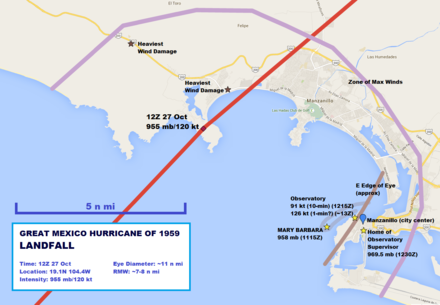03 February 2016
Great Mexico Hurricane of 1959: A Contemporary Reanalysis

I'm pleased to announce the completion of our reanalysis of the Great Mexico Hurricane of 1959, as well as the National Hurricane Center's official acceptance of our findings.
Our complete paper can de downloaded here:
59 Hurricane Reanalysis
Sources: https://goo.gl/SjEc5p
This intense cyclone—also known as the Manzanillo Hurricane—is the most tragic of all Pacific coast hurricanes in Mexico. It devastated the port city of Manzanillo and went on to cause catastrophic inland flooding, killing an estimated 1,800 people.
We believe ours is the deepest study ever performed on this historic cyclone. Our exhaustive research turned up a wide range of sources in Mexico and the USA: ship reports, synoptic maps, official data, old government archives, science journals, newspaper articles, eyewitness accounts, personal and official letters, a book, and even conversations with Mexican government personnel. A close analysis of these sources led us to conclude this was a small, extremely severe Category-4 hurricane that came ashore at the W end of Manzanillo Harbor.
Our reconstructed track presents significant changes from the traditional HURDAT record of this storm:
- Landfall time: 12Z 27 Oct—6 hours later than the original time.
- Landfall location: near Santiago Bay (19.1N 104.4W)—25 n mi ESE of the original location and much closer to Manzanillo.
- Landfall intensity: 955 mb/120 knots (140 mph)—significantly lower than the original 140 knots, but still a powerful Cat-4 hurricane.
—Josh Morgerman
